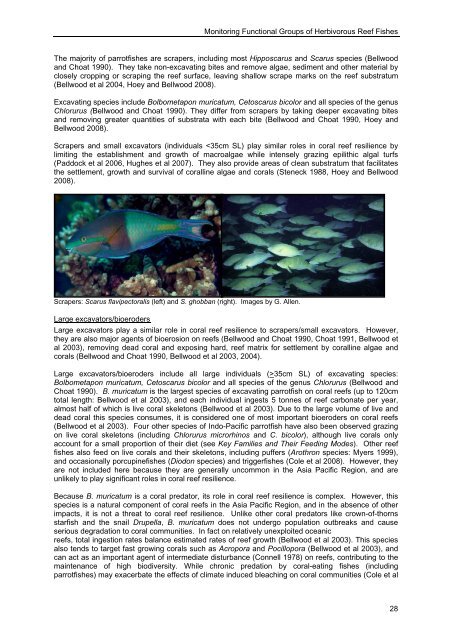Green2009-herbivore monitoring
Green2009-herbivore monitoring.pdf
Green2009-herbivore monitoring.pdf
You also want an ePaper? Increase the reach of your titles
YUMPU automatically turns print PDFs into web optimized ePapers that Google loves.
Monitoring Functional Groups of Herbivorous Reef Fishes<br />
The majority of parrotfishes are scrapers, including most Hipposcarus and Scarus species (Bellwood<br />
and Choat 1990). They take non-excavating bites and remove algae, sediment and other material by<br />
closely cropping or scraping the reef surface, leaving shallow scrape marks on the reef substratum<br />
(Bellwood et al 2004, Hoey and Bellwood 2008).<br />
Excavating species include Bolbometapon muricatum, Cetoscarus bicolor and all species of the genus<br />
Chlorurus (Bellwood and Choat 1990). They differ from scrapers by taking deeper excavating bites<br />
and removing greater quantities of substrata with each bite (Bellwood and Choat 1990, Hoey and<br />
Bellwood 2008).<br />
Scrapers and small excavators (individuals 35cm SL) of excavating species:<br />
Bolbometapon muricatum, Cetoscarus bicolor and all species of the genus Chlorurus (Bellwood and<br />
Choat 1990). B. muricatum is the largest species of excavating parrotfish on coral reefs (up to 120cm<br />
total length: Bellwood et al 2003), and each individual ingests 5 tonnes of reef carbonate per year,<br />
almost half of which is live coral skeletons (Bellwood et al 2003). Due to the large volume of live and<br />
dead coral this species consumes, it is considered one of most important bioeroders on coral reefs<br />
(Bellwood et al 2003). Four other species of Indo-Pacific parrotfish have also been observed grazing<br />
on live coral skeletons (including Chlorurus microrhinos and C. bicolor), although live corals only<br />
account for a small proportion of their diet (see Key Families and Their Feeding Modes). Other reef<br />
fishes also feed on live corals and their skeletons, including puffers (Arothron species: Myers 1999),<br />
and occasionally porcupinefishes (Diodon species) and triggerfishes (Cole et al 2008). However, they<br />
are not included here because they are generally uncommon in the Asia Pacific Region, and are<br />
unlikely to play significant roles in coral reef resilience.<br />
Because B. muricatum is a coral predator, its role in coral reef resilience is complex. However, this<br />
species is a natural component of coral reefs in the Asia Pacific Region, and in the absence of other<br />
impacts, it is not a threat to coral reef resilience. Unlike other coral predators like crown-of-thorns<br />
starfish and the snail Drupella, B. muricatum does not undergo population outbreaks and cause<br />
serious degradation to coral communities. In fact on relatively unexploited oceanic<br />
reefs, total ingestion rates balance estimated rates of reef growth (Bellwood et al 2003). This species<br />
also tends to target fast growing corals such as Acropora and Pocillopora (Bellwood et al 2003), and<br />
can act as an important agent of intermediate disturbance (Connell 1978) on reefs, contributing to the<br />
maintenance of high biodiversity. While chronic predation by coral-eating fishes (including<br />
parrotfishes) may exacerbate the effects of climate induced bleaching on coral communities (Cole et al<br />
28


















